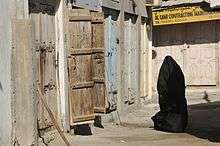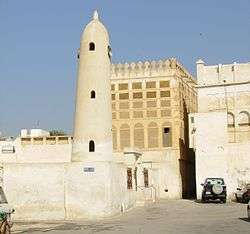Bahrain Pearling Trail
 View of the Suq in Muharraq, part of the Pearling Pathway | |
| UNESCO World Heritage Site | |
|---|---|
| Location |
Bahrain |
| Coordinates | 26°15′N 50°37′E / 26.25°N 50.61°E |
| Criteria | Cultural: (iii)[1] |
| Reference | 1364 |
| Inscription | 2012 (36th Session) |
 Location of Bahrain Pearling Trail | |
The Bahrain Pearling Trail or Bahrain Pearling Pathway is a serial cultural heritage site inscribed on the UNESCO World Heritage List in 2012.[2] It consists of 3 oyster beds in the Bahrain northern waters, a segment of the coast and the seafront Bu Mahir fortress in the southern tip of Muharraq,[3] and 17 buildings in Muharraq historical town connected by a 3.5 km visitor pathway.[4] The Site was inscribed as a UNESCO World Heritage Site on June 30, 2012 and is Bahrain's second World Heritage Site after the Bahrain Fort.[5]
Naming
Though the Site was inscribed under the label: "Pearling, testimony of an island economy" by the Bahrain Ministry of Culture, the international media has consistently referred to it as the "Bahrain pearling trail".[6][7]
Background history
Pearl diving in Bahrain was first mentioned in Assyrian texts dating to 2000 BC, referring to "fish eyes" from Dilmun (the ancient name of Bahrain).[8] Bahrain (as Tylos, Bahrain's Greek name) was mentioned by Pliny to have been, "famous for the vast number of its pearls".[8] The golden age of pearling is stated to have been between the 1850s to 1930, when pearls were more precious than diamonds and had attracted jewelers like Jacques Cartier to the country.[8] There were around 30,000 pearl divers by the end of 1930, as pearling was the principal industry in Bahrain prior to the discovery of oil in 1932. After the collapse of the pearling industry, most divers switched to the newly founded oil sector.[8]
Currently, the trading of cultured pearls in Bahrain is prohibited.[8] Few pearl divers remain today.[8]

Description
UNESCO has stated that:
The site is the last remaining complete example of the cultural tradition of pearling and the wealth it generated at a time when the trade dominated the Gulf economy (2nd century to the 1930s when Japan developed cultured pearls). It also constitutes an outstanding example of traditional utilization of the sea’s resources and human interaction with the environment, which shaped both the economy and cultural identity of the island’s society.
The buildings listed were the residences and majlises of rich pearl merchants, along with shopping establishments, storage houses and the Siyadi family mosque.[2][9]
References
- ↑ http://whc.unesco.org/en/list/1364.
- 1 2 3 "UNESCO World Heritage Site Profile". UNESCO. Retrieved 1 July 2012.
- ↑ "Bu Maher Fort, Bahrain". Oxford Brookes University. Archived from the original on 14 December 2012. Retrieved 3 July 2012.
- ↑ "UN heritage listing to spur Bahrain tourism". Trade Arabia. Retrieved 2 July 2012.
- ↑ "Bahraini pearling site and the Mosque of Isfahan inscribed on UNESCO’s World Heritage List". UNESCO. Retrieved 1 July 2012.
- ↑ "Pearling Trail on UN World Heritage list". Trade Arabia. 1 July 2012. Retrieved 1 July 2012.
- ↑ "Bahrain Pearling Trail on UN World Heritage list". Gulf Daily News. 1 July 2012. Retrieved 1 July 2012.
- 1 2 3 4 5 6 Stuart, Julia (16 January 2010). "The pearl fishers: The waters surrounding the island of Bahrain Harbour untold hidden wealth". The Independent. London. Retrieved 2 July 2012.
- ↑ "Discovering Muharraq's hidden charms". Bahrain Guide. Retrieved 3 July 2012.
External links
Coordinates: 26°15′N 50°37′E / 26.25°N 50.61°E